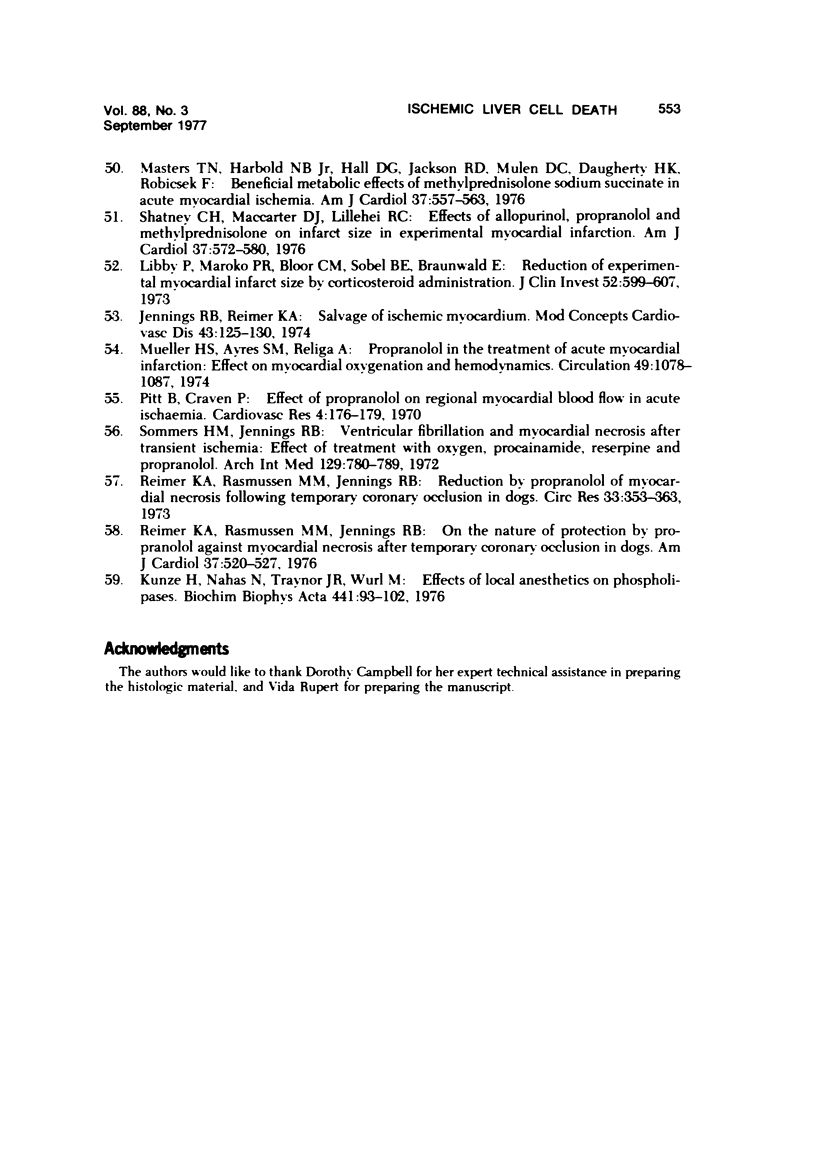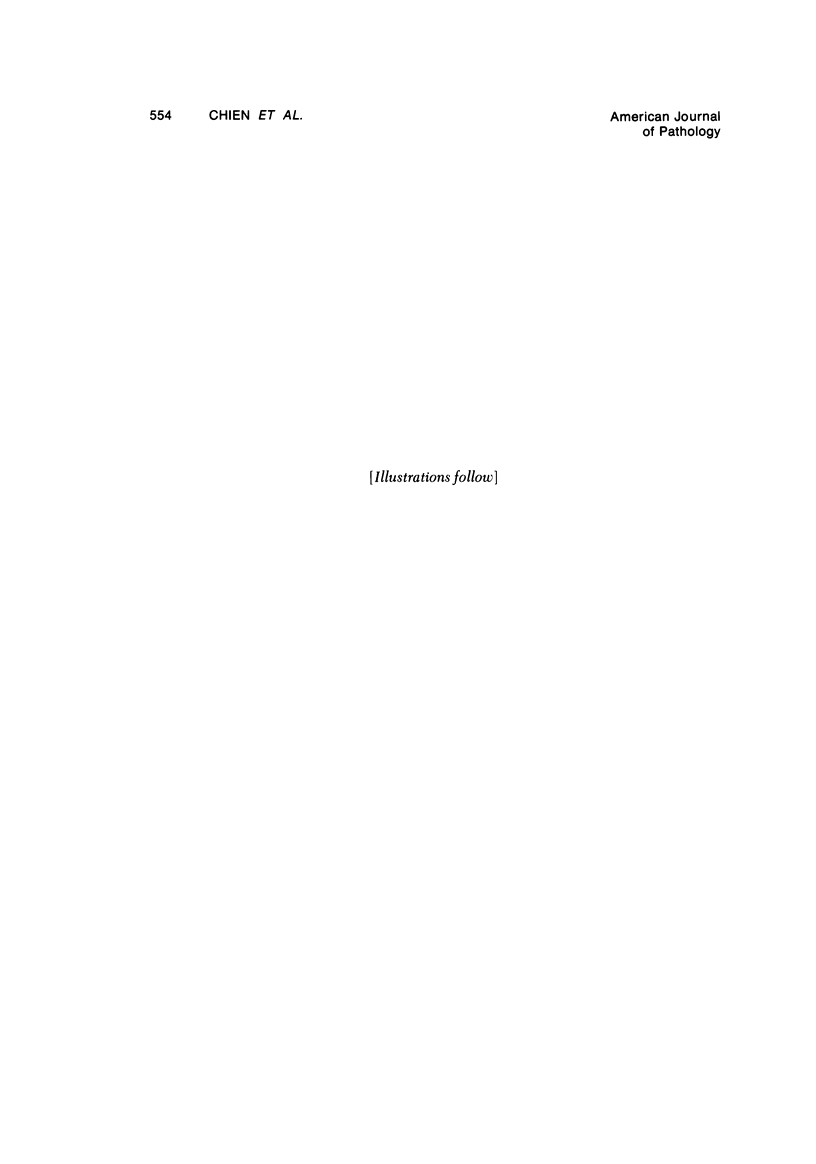Abstract
Ischemic liver tissue was produced by clamping the portal venous and hepatic arterial blood supply to the left lateral and median lobes of rat liver. If, after 2 to 3 hours of ischemia, reflow to the liver was established by removing the clamp, two-thirds or more of the liver cells were histologically dead 24 hours later. Pretreatment with chlorpromazine (20 mg/kg) 30 minutes before inducing ischemia for up to 3 hours virtually completely prevented this ischemic cell death. If the animals were kept alive for an additional 24 hours with no further treatment, the extent of liver cell necrosis at 48 hours was still markedly less than that seen in the untreated ischemic controls. Administration of chlorpromazine after induction of ischemia and immediately prior to the onset of reflow reduced but did not completely prevent ischemic cell death as determined at 24 hours. This protective action of chlorpromazine was confirmed by the ability of the treated animals to regenerate cellular ATP levels after 3 hours of ischemia. In addition, chlorpromazine was shown to significantly reduce the increases in total liver cell and mitochondrial calcium ion contents that accompany the return of blood flow to irreversibly injured liver cells. The protective effect of chlorpromazine could not be attributed to any effect either on the rate or extent to which the liver cells became ischemic or on the perfusion patterns following release of the obstruction, and it is concluded that the action of chlorpromazine must be on some component(s) of the reaction of the cells to the ischemia itself. The possible basis of this action is discussed.
Full text
PDF


















Images in this article
Selected References
These references are in PubMed. This may not be the complete list of references from this article.
- AUSTEN W. G., GREENBERG J. J., PICCININI J. C. MYOCARDIAL FUNCTION AND CONTRACTILE FORCE AFFECTED BY GLUCOSE LOADING OF THE HEART DURING ANOXIA. Surgery. 1965 Jun;57:839–845. [PubMed] [Google Scholar]
- Ames A., 3rd, Wright R. L., Kowada M., Thurston J. M., Majno G. Cerebral ischemia. II. The no-reflow phenomenon. Am J Pathol. 1968 Feb;52(2):437–453. [PMC free article] [PubMed] [Google Scholar]
- BASSI M., BERNELLI-ZAZZERA A. ULTRASTRUCTURAL CYTOPLASMIC CHANGES OF LIVER CELLS AFTER REVERSIBLE AND IRREVERSIBLE ISCHEMIA. Exp Mol Pathol. 1964 Aug;17:332–350. doi: 10.1016/0014-4800(64)90006-1. [DOI] [PubMed] [Google Scholar]
- Brachfeld N. Metabolic evaluation of agents designed to protect the ischemic myocardium and to reduce infarct size. Am J Cardiol. 1976 Mar 31;37(4):528–532. doi: 10.1016/0002-9149(76)90392-1. [DOI] [PubMed] [Google Scholar]
- Brachfeld N. The glucose-insulin-potassium (GIK) regimen in the treatment of myocardial ischemia. Circulation. 1973 Sep;48(3):459–462. doi: 10.1161/01.cir.48.3.459. [DOI] [PubMed] [Google Scholar]
- Braunwald E., Maroko P. R. Effects of hyaluronidase and hydrocortisone on myocardial necrosis after coronary occlusion. Am J Cardiol. 1976 Mar 31;37(4):550–556. doi: 10.1016/0002-9149(76)90395-7. [DOI] [PubMed] [Google Scholar]
- Burke W. M., Asokan S. K., Moschos C. B., Oldewurtel H. A., Regan T. J. Effects of glucose and nonglucose infusions on myocardial potassium ion transfers and arrhythmias during ischemia. Am J Cardiol. 1969 Nov;24(5):713–722. doi: 10.1016/0002-9149(69)90459-7. [DOI] [PubMed] [Google Scholar]
- Calva E., Mújica A., Núez R., Aoki K., Bisteni A., Sodi-Pallares D. Mitochondrial biochemical changes and glucose-KCl-insulin solution in cardiac infarct. Am J Physiol. 1966 Jul;211(1):71–76. doi: 10.1152/ajplegacy.1966.211.1.71. [DOI] [PubMed] [Google Scholar]
- Chien K. R., Farber J. L. Microsomal membrane dysfunction in ischemic rat liver cells. Arch Biochem Biophys. 1977 Apr 15;180(1):191–198. doi: 10.1016/0003-9861(77)90025-x. [DOI] [PubMed] [Google Scholar]
- El-Mofty S. K., Scrutton M. C., Serroni A., Nicolini C., Farber J. L. Early, reversible plasma membrane injury in galactosamine-induced liver cell death. Am J Pathol. 1975 Jun;79(3):579–596. [PMC free article] [PubMed] [Google Scholar]
- Farber J. L., El-Mofty S. K., Schanne F. A., Aleo J. J., Jr, Serroni A. Intracellular calcium homeostasis in galactosamine-intoxicated rat liver cells. Active sequestration of calcium by microsomes and mitochondria. Arch Biochem Biophys. 1977 Jan 30;178(2):617–624. doi: 10.1016/0003-9861(77)90233-8. [DOI] [PubMed] [Google Scholar]
- Farber J. L., El-Mofty S. K. The biochemical pathology of liver cell necrosis. Am J Pathol. 1975 Oct;81(1):237–250. [PMC free article] [PubMed] [Google Scholar]
- Flores J., DiBona D. R., Beck C. H., Leaf A. The role of cell swelling in ischemic renal damage and the protective effect of hypertonic solute. J Clin Invest. 1972 Jan;51(1):118–126. doi: 10.1172/JCI106781. [DOI] [PMC free article] [PubMed] [Google Scholar]
- Franklin W. A., Ganote C. E., Jennings R. B. Blood reflow after renal ischemia. Effects of hypertonic mannitol on reflow and tubular necrosis after transient ischemia in the rat. Arch Pathol. 1974 Aug;98(2):106–111. [PubMed] [Google Scholar]
- GALLAGHER C. H., GUPTA D. N., JUDAH J. D., REES K. R. Biochemical changes in liver in acute thioacetamide intoxication. J Pathol Bacteriol. 1956 Jul;72(1):193–201. doi: 10.1002/path.1700720125. [DOI] [PubMed] [Google Scholar]
- GUTH P. S., SPIRTES M. A. THE PHENOTHIAZINETRANQUILIZERS: BIOCHEMICAL AND BIOPHYSICAL ACTIONS. Int Rev Neurobiol. 1964;7:231–278. doi: 10.1016/s0074-7742(08)60269-x. [DOI] [PubMed] [Google Scholar]
- Godfraind T., Kaba A. Blockade or reversal of the contraction induced by calcium and adrenaline in depolarized arterial smooth muscle. Br J Pharmacol. 1969 Jul;36(3):549–560. doi: 10.1111/j.1476-5381.1969.tb08010.x. [DOI] [PMC free article] [PubMed] [Google Scholar]
- Hearse D. J., Chain E. B. The role of glucose in the survival and 'recovery' of the anoxic isolated perfused rat heart. Biochem J. 1972 Aug;128(5):1125–1133. doi: 10.1042/bj1281125. [DOI] [PMC free article] [PubMed] [Google Scholar]
- JUDAH J. D., BJOTVEDT G., VAINIO T. Protection against liver injury due to murine hepatitis virus. Nature. 1960 Aug 6;187:507–508. doi: 10.1038/187507a0. [DOI] [PubMed] [Google Scholar]
- Kunze H., Nahas N., Traynor J. R., Wurl M. Effects of local anaesthetics on phospholipases. Biochim Biophys Acta. 1976 Jul 20;441(1):93–102. doi: 10.1016/0005-2760(76)90284-8. [DOI] [PubMed] [Google Scholar]
- LOWRY O. H., ROSEBROUGH N. J., FARR A. L., RANDALL R. J. Protein measurement with the Folin phenol reagent. J Biol Chem. 1951 Nov;193(1):265–275. [PubMed] [Google Scholar]
- Laiho K. U., Trump B. F. The relationship between cell viability and changes in mitochondrial ultrastructure, cellular ATP, ion and water content following injury of Ehrlich ascites tumor cells. Virchows Arch B Cell Pathol. 1974;15(4):267–277. doi: 10.1007/BF02889343. [DOI] [PubMed] [Google Scholar]
- Leaf A. Cell swelling. A factor in ischemic tissue injury. Circulation. 1973 Sep;48(3):455–458. doi: 10.1161/01.cir.48.3.455. [DOI] [PubMed] [Google Scholar]
- Leaf A. Regulation of intracellular fluid volume and disease. Am J Med. 1970 Sep;49(3):291–295. doi: 10.1016/s0002-9343(70)80019-5. [DOI] [PubMed] [Google Scholar]
- Libby P., Maroko P. R., Bloor C. M., Sobel B. E., Braunwald E. Reduction of experimental myocardial infarct size by corticosteroid administration. J Clin Invest. 1973 Mar;52(3):599–607. doi: 10.1172/JCI107221. [DOI] [PMC free article] [PubMed] [Google Scholar]
- MARTINS DE OLIVEIRA J., CARBALLO R., ZIMMERMAN H. A. Intravenous injection of hyaluronidase in acute myocardial infarction: preliminary report of clinical and experimental observations. Am Heart J. 1959 May;57(5):712–722. doi: 10.1016/0002-8703(59)90180-2. [DOI] [PubMed] [Google Scholar]
- Maclean D., Fishbein M. C., Maroko P. R., Braunwald E. Hyaluronidase-induced reductions in myocardial infarct size. Science. 1976 Oct 8;194(4261):199–200. doi: 10.1126/science.959848. [DOI] [PubMed] [Google Scholar]
- Maroko P. R., Davidson D. M., Libby P., Hagan A. D., Braunwald E. Effects of hyaluronidase administration on myocardial ischemic injury in acute infarction. A preliminary study in 24 patients. Ann Intern Med. 1975 Apr;82(4):516–520. doi: 10.7326/0003-4819-82-4-516. [DOI] [PubMed] [Google Scholar]
- Maroko P. R., Libby P., Bloor C. M., Sobel B. E., Braunwald E. Reduction by hyaluronidase of myocardial necrosis following coronary artery occlusion. Circulation. 1972 Sep;46(3):430–437. doi: 10.1161/01.cir.46.3.430. [DOI] [PubMed] [Google Scholar]
- Masters T. N., Harbold N. B., Jr, Hall D. G., Jackson R. D., Mullen D. C., Daugherty H. K., Robicsek F. Beneficial metabolic effects of methylprednisolone sodium succinate in acute myocardial ischemia. Am J Cardiol. 1976 Mar 31;37(4):557–563. doi: 10.1016/0002-9149(76)90396-9. [DOI] [PubMed] [Google Scholar]
- Mittra B. Potassium, glucose, and insulin in treatment of myocardial infarction. Br Heart J. 1967 Jul;29(4):616–620. doi: 10.1136/hrt.29.4.616. [DOI] [PMC free article] [PubMed] [Google Scholar]
- Mueller H. S., Ayres S. M., Religa A., Evans R. G. Propranolol in the treatment of acute myocardial infarction. Effect on myocardial oxygenation and hemodynamics. Circulation. 1974 Jun;49(6):1078–1087. doi: 10.1161/01.cir.49.6.1078. [DOI] [PubMed] [Google Scholar]
- Osher J., Lang T. W., Meerbaum S., Hashimoto K., Farcot J. C., Corday E. Methylprednisolone treatment in acute myocardial infarction. Effect on regional and global myocardial function. Am J Cardiol. 1976 Mar 31;37(4):564–571. doi: 10.1016/0002-9149(76)90397-0. [DOI] [PubMed] [Google Scholar]
- Pitt B., Craven P. Effect of propranolol on regional myocardial blood flow in acute ischaemia. Cardiovasc Res. 1970 Apr;4(2):176–179. doi: 10.1093/cvr/4.2.176. [DOI] [PubMed] [Google Scholar]
- REES K. R., SINHA K. P., SPECTOR W. G. The pathogenesis of liver injury in carbon tetrachloride and thioacetamide poisoning. J Pathol Bacteriol. 1961 Jan;81:107–118. [PubMed] [Google Scholar]
- REES K. R., SPECTOR W. G. Reversible nature of liver cell damage due to carbon tetrachloride as demonstrated by the use of phenergan. Nature. 1961 May 27;190:821–822. doi: 10.1038/190821a0. [DOI] [PubMed] [Google Scholar]
- Regan T. J., Harman M. A., Lehan P. H., Burke W. M., Oldewurtel H. A. Ventricular arrhythmias and K+ transfer during myocardial ischemia and intervention with procaine amide, insulin, or glucose solution. J Clin Invest. 1967 Oct;46(10):1657–1668. doi: 10.1172/JCI105657. [DOI] [PMC free article] [PubMed] [Google Scholar]
- Reimer K. A., Rasmussen M. M., Jennings R. B. On the nature of protection by propranolol against myocardial necrosis after temporary coronary occlusion in dogs. Am J Cardiol. 1976 Mar 31;37(4):520–527. doi: 10.1016/0002-9149(76)90391-x. [DOI] [PubMed] [Google Scholar]
- Reimer K. A., Rasmussen M. M., Jennings R. B. Reduction by propranolol of myocardial necrosis following temporary coronary artery occlusion in dogs. Circ Res. 1973 Sep;33(3):353–363. doi: 10.1161/01.res.33.3.353. [DOI] [PubMed] [Google Scholar]
- Seeman P. M. Membrane stabilization by drugs: tranquilizers, steroids, and anesthetics. Int Rev Neurobiol. 1966;9:145–221. doi: 10.1016/s0074-7742(08)60138-5. [DOI] [PubMed] [Google Scholar]
- Seeman P., Chen S. S., Chau-Wong M., Staiman A. Calcium reversal of nerve blockade by alcohols, anesthetics, tranquilizers, and barbiturates. Can J Physiol Pharmacol. 1974 Jun;52(3):526–534. doi: 10.1139/y74-070. [DOI] [PubMed] [Google Scholar]
- Seeman P. The membrane actions of anesthetics and tranquilizers. Pharmacol Rev. 1972 Dec;24(4):583–655. [PubMed] [Google Scholar]
- Serur J. R., Urschel C. W., Sonnenblick E. H., Laraia P. J. Experimental myocardial ischemia. III. Protective effect of glucose of myocardial function. J Mol Cell Cardiol. 1976 Jul;8(7):521–531. doi: 10.1016/0022-2828(76)90053-5. [DOI] [PubMed] [Google Scholar]
- Shatney C. H., MacCarter D. J., Lillehei R. C. Effects of allopurinol, propranolol and methylprednisolone on infarct size in experimental myocardial infarction. Am J Cardiol. 1976 Mar 31;37(4):572–580. doi: 10.1016/0002-9149(76)90398-2. [DOI] [PubMed] [Google Scholar]
- Sommers H. M., Jennings R. B. Ventricular fibrillation and myocardial necrosis after transient ischemia. Effect of treatment with oxygen, procainamide, reserpine, and propranolol. Arch Intern Med. 1972 May;129(5):780–789. [PubMed] [Google Scholar]
- Trump B. F., Laiho K. U. Studies of cellular recovery from injury. I. Recovery from anoxia in Ehrlich ascites tumor cells. Lab Invest. 1975 Dec;33(6):706–711. [PubMed] [Google Scholar]
- VAINIO T., JUDAH J. D., BJOTVEDT G. Mechanism of cellular damage by virus: a study of antihistamine drugs. I. Murine hepatitis virus and liver explant cultures. Exp Mol Pathol. 1962 Feb;1:15–26. doi: 10.1016/0014-4800(62)90004-7. [DOI] [PubMed] [Google Scholar]
- Van Bossum G. D., Smith K. P., Beeton P. Role of mitochondria in control of calcium content of liver slices. Nature. 1976 Mar 25;260(5549):335–337. doi: 10.1038/260335a0. [DOI] [PubMed] [Google Scholar]
- Vogt M. T., Farber E. On the molecular pathology of ischemic renal cell death. Reversible and irreversible cellular and mitochondrial metabolic alterations. Am J Pathol. 1968 Jul;53(1):1–26. [PMC free article] [PubMed] [Google Scholar]
- Whalen D. A., Jr, Hamilton D. G., Ganote C. E., Jennings R. B. Effect of a transient period of ischemia on myocardial cells. I. Effects on cell volume regulation. Am J Pathol. 1974 Mar;74(3):381–397. [PMC free article] [PubMed] [Google Scholar]







